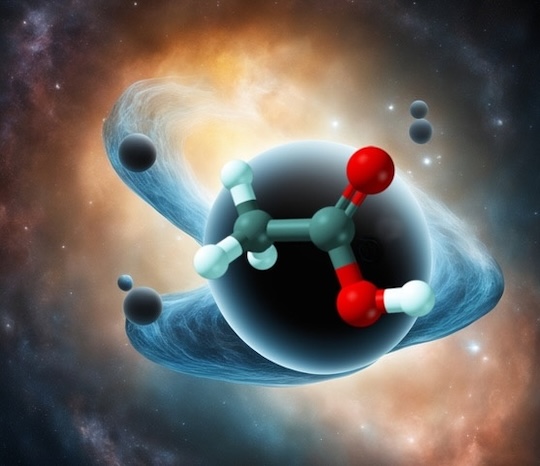博文
化学反应可以扰乱量子信息,也可以扰乱黑洞
||
化学反应可以扰乱量子信息,也可以扰乱黑洞
诸平
据美国莱斯大学(Rice University, Houston, TX, USA)网站2024年4月5日报道,化学反应可以扰乱量子信息,也可以扰乱黑洞(Chemical reactions can scramble quantum information as well as black holes)。
如果你把一个装在瓶子里的信息扔进黑洞,瓶子里的所有信息,直到量子水平,都会被完全打乱。因为在量子力学允许的范围内,这种混乱发生得最快、最彻底,所以黑洞通常被认为是大自然的终极信息混乱者(ultimate information scramblers)。
然而,莱斯大学的理论学家彼得·沃利内斯(Peter Wolynes, Fig. 3)和美国伊利诺伊大学厄巴纳-香槟分校(University of Illinois Urbana-Champaign, IL, USA)的合作者的新研究表明,分子在扰乱量子信息方面可以像黑洞一样强大。结合黑洞物理学和化学物理学的数学工具,他们已经证明,量子信息混乱发生在化学反应中,并且几乎可以达到与黑洞中相同的量子力学极限。这项研究于2024年4月1日已经在《美国国家科学院院刊》(Proceedings of the National Academy of Sciences)网站发表——Chenghao Zhang, Sohang Kundu, Nancy Makri, Martin Gruebele, Peter Wolynes. Quantum information scrambling and chemical reactions. Proceedings of the National Academy of Sciences,2024, 121 (15): e2321668121. DOI: 10.1073/pnas.2321668121. Published online: April 1, 2024. https://www.pnas.org/doi/10.1073/pnas.2321668121
彼得·沃利内斯说:“这项研究解决了化学物理学中一个长期存在的问题,即量子信息在分子中被打乱的速度有多快。当人们想到两个分子聚集在一起的反应时,他们认为原子只会在成键或断键时进行单一的运动。但是从量子力学的角度来看,即使一个很小的分子也是一个非常复杂的系统。就像太阳系的轨道一样,一个分子有很多可能的运动方式我们称之为量子态。当化学反应发生时,关于反应物量子态的量子信息被打乱了,我们想知道信息打乱是如何影响反应速率的。”
为了更好地理解量子信息在化学反应中是如何被打乱的,科学家借用了一种通常用于黑洞物理学的数学工具,即超时序相关器(out-of-time-order correlators简称OTOCs)。
彼得·沃利内斯说:“大约55年前,OTOCs实际上是在一个非常不同的背景下发明的,当时它们被用来观察超导体中的电子如何受到杂质干扰的影响。它们是在超导理论中使用的非常特殊的物体。20世纪90年代,物理学家们又用它们来研究黑洞和弦理论(string theory)。”
OTOCs测量的是在某个时刻对量子系统的一部分进行调整,会对其他部分的运动产生多大影响,从而深入了解信息在整个分子中传播的速度和有效性。它们是李雅普诺夫指数(Lyapunov exponents)的量子模拟,用来测量经典混沌系统(classical chaotic systems)中的不可预测性(unpredictability)。
伊利诺伊大学厄巴纳-香槟分校的化学家马丁·格鲁埃贝勒(Martin Gruebele, Fig.3)说:“OTOC随时间增加的速度告诉你信息在量子系统中被打乱的速度有多快,这意味着有多少看起来随机的状态被访问了。”马丁·格鲁埃贝勒是这项研究的合著者,他是由美国国家科学基金会(National Science Foundation)资助的赖斯-伊利诺伊将缺陷改编为特征联合中心(Rice-Illinois Center for Adapting Flaws as Features)的一部分。“化学家对化学反应的混乱很矛盾,因为混乱是达到反应目标的必要条件,但它也会破坏你对反应的控制。
了解分子在什么情况下扰乱信息,什么情况下不扰乱信息,可能会让我们更好地控制反应。了解OTOCs基本上可以让我们限制这些信息何时真正从我们的控制中消失,相反,我们仍然可以利用它来控制结果。”
在经典力学中,粒子必须有足够的能量来克服能垒,才能发生反应。但是,在量子力学中,即使粒子没有足够的能量,也有可能穿过这个屏障。OTOCs的计算表明,在低温下,隧道作用占主导地位的低活化能化学反应可以在接近量子极限的情况下扰乱信息,就像黑洞一样。
南希·马克里(Nancy Makri, Fig. 3)也是伊利诺伊大学厄巴纳-香槟分校的化学家,她使用自己开发的路径积分方法,来研究当简单的化学反应模型嵌入一个更大的系统(可能是大分子自身的振动或溶剂)时会发生什么,并倾向于抑制混沌运动(chaotic motion)。
南希·马克里说:“在另一项研究中,我们发现大环境往往会使事情变得更有规律,并抑制我们所说的影响。所以我们计算了一个隧道系统与一个大环境相互作用的OTOC,我们看到的是混乱被消除了——行为发生了很大的变化。”
上述研究结果的一个实际应用领域是限制隧道系统如何用于为量子计算机构建量子比特。人们需要将相互作用的隧道系统之间的信息混乱最小化,以提高量子计算机的可靠性。这项研究也可能与光驱动反应和先进材料设计有关。
马丁·格鲁埃贝勒说:“有可能将这些想法扩展到不只在一个特定的反应中隧穿,而是有多个隧穿步骤的过程中,因为这是涉及到的,例如,在许多新的软量子材料中,如用于制造太阳能电池和类似东西的钙钛矿(perovskites)中的电子传导。”
上述论文的合著者彼得·沃利内斯是莱斯大学布拉德-韦尔奇基金会的科学教授(Rice’s D.R. Bullard-Welch Foundation Professor of Science),是化学、生物化学和细胞生物学、物理学和天文学、材料科学和纳米工程的教授,也是由美国国家科学基金会资助的理论生物物理中心(Center for Theoretical Biological Physics)的联合主任。合著者马丁·格鲁埃贝勒是詹姆斯·艾斯纳化学教授(James R. Eiszner Endowed Chair in Chemistry);南希·马克里是爱德华·威廉(Edward William)和简·马尔·古塞尔(Jane Marr Gutgsell)教授以及化学和物理教授;张成豪(Chenghao Zhang音译, Fig. 2),伊利诺伊大学厄巴纳-香槟分校物理学研究生,现为美国西北太平洋国家实验室(Pacific Northwest National Lab)博士后; Sohang Kundu (Fig. 2)最近在伊利诺伊大学获得化学博士学位,目前是哥伦比亚大学(Columbia University)的博士后。
本研究得到了美国国家科学基金会(National Science Foundation简称NSF)拨款资助(NSF grant ACI-1548562; NSF grant PHY- 2019745; NSF under CHE-1955302)和美国莱斯大学布拉德-韦尔奇主席的支持(D. R. Bullard Welch Chair at Rice University, Grant C-0016)。
上述介绍,仅供参考。欲了解更多信息,敬请注意浏览原文或者相关报道。
The “butterfly effect” causes the beating of an insect wing to change history, but how does this phenomenon manifest itself at the quantum level of chemical reactions, where atoms and electrons move about? We show, using fully quantum-mechanical wavefunction and path integral calculations of a simple chemical reaction, that scrambling of information in certain types of reactions can be nearly as fast as nature’s ultimate information scrambler, a black hole. At the same time, the rate can approach the “prefactor” of transition state theory for such reactions, assisted by tunneling and by molecular vibrations.
The ultimate regularity of quantum mechanics creates a tension with the assumption of classical chaos used in many of our pictures of chemical reaction dynamics. Out-of-time-order correlators (OTOCs) provide a quantum analog to the Lyapunov exponents that characterize classical chaotic motion. Maldacena, Shenker, and Stanford have suggested a fundamental quantum bound for the rate of information scrambling, which resembles a limit suggested by Herzfeld for chemical reaction rates. Here, we use OTOCs to study model reactions based on a double-well reaction coordinate coupled to anharmonic oscillators or to a continuum oscillator bath. Upon cooling, as one enters the tunneling regime where the reaction rate does not strongly depend on temperature, the quantum Lyapunov exponent can approach the scrambling bound and the effective reaction rate obtained from a population correlation function can approach the Herzfeld limit on reaction rates: Tunneling increases scrambling by expanding the state space available to the system. The coupling of a dissipative continuum bath to the reaction coordinate reduces the scrambling rate obtained from the early-time OTOC, thus making the scrambling bound harder to reach, in the same way that friction is known to lower the temperature at which thermally activated barrier crossing goes over to the low-temperature activationless tunneling regime. Thus, chemical reactions entering the tunneling regime can be information scramblers as powerful as the black holes to which the quantum Lyapunov exponent bound has usually been applied.
https://blog.sciencenet.cn/blog-212210-1428613.html
上一篇:阿尔茨海默氏症的突破:科学家们在大脑网络分析方面取得了革命性的飞跃
下一篇:令人难以置信的幸运,科学家揭示了一位绕过阿尔茨海默症的女士


